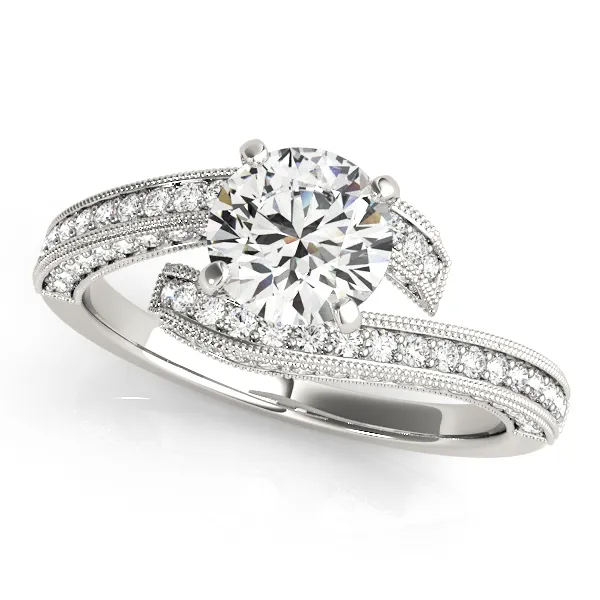When it comes to engagement rings, the diamond has long been the gemstone of choice for couples around the world. However, in recent years, a new contender has emerged in the form of lab-grown diamonds—an ethical, environmentally friendly, and cost-effective alternative to traditional mined diamonds. As more couples seek sustainable options and a deeper connection to the values represented in their love story, lab-grown diamonds are becoming a popular choice for engagement rings.
In this article, we’ll explore what lab-grown diamonds are, how they compare to natural diamonds, and why they might be the perfect choice for your engagement ring. Whether you’re looking for an eco-friendly option, a more budget-conscious solution, or simply something innovative and unique, lab-grown diamonds offer a modern, forward-thinking alternative to the traditional diamond.
The Engagement ring you choose is one of the most exciting and important choices you’ll ever have to make. An engagement ring is a sign of love and loyalty. At Carat Diamonds, we have a beautiful selection of engagement rings to fit any style or personality. Our lab-grown diamonds are just as beautiful and brilliant as real diamonds, but they cost less. They can be used in traditional solitaires or more modern halo designs.
What Are Lab-Grown Diamonds?
Lab-grown diamonds, also known as synthetic or cultured diamonds, are real diamonds that are created in a laboratory rather than being mined from the earth. They have the same chemical, physical, and optical properties as natural diamonds, meaning they are composed of pure carbon atoms arranged in the same crystal structure.
The process of creating lab-grown diamonds involves replicating the conditions under which natural diamonds form deep within the Earth’s mantle, but in a controlled environment. There are two primary methods used to produce lab-grown diamonds:
- High Pressure, High Temperature (HPHT) Method: This process mimics the natural conditions under which diamonds form. Carbon is subjected to high pressure and temperature, resulting in the growth of a diamond crystal. HPHT diamonds tend to have fewer inclusions and can be produced in a variety of colors.
- Chemical Vapor Deposition (CVD) Method: In the CVD process, a diamond seed is placed in a chamber where carbon-rich gases are introduced. These gases break down, and the carbon atoms are deposited onto the seed, allowing it to grow into a diamond over time. CVD diamonds are often the preferred choice for larger stones and can be grown in a wide range of colors, including fancy yellow, pink, and blue.
Both methods create diamonds that are identical to mined diamonds in terms of hardness, clarity, color, and brilliance. In fact, the only real difference between lab-grown diamonds and natural diamonds is their origin.
How Lab-Grown Diamonds Compare to Natural Diamonds
1. Price
One of the most significant advantages of lab-grown diamonds is their affordability. Because they are produced in a laboratory rather than being mined from the earth, lab-grown diamonds can cost up to 40% less than their natural counterparts. This price difference allows you to get a larger or higher-quality diamond for the same budget, or to allocate funds to other aspects of the ring, such as a more intricate setting or high-quality metals.
2. Environmental Impact
The environmental impact of traditional diamond mining has long been a concern. Diamond mining often involves the destruction of large areas of land, including forests and ecosystems, and can lead to soil erosion, water pollution, and the depletion of natural resources. The mining process also requires significant energy and water, further contributing to its environmental footprint.
Lab-grown diamonds, on the other hand, are far more sustainable. Because they are produced in a controlled environment, they have a minimal impact on the environment. There is no large-scale land destruction, and the carbon footprint of lab-grown diamonds is significantly lower than that of mined diamonds. Moreover, some diamond manufacturers use renewable energy sources in the production of lab-grown diamonds, further reducing their environmental impact.
3. Ethical Considerations
Another key advantage of lab-grown diamonds is their ethical sourcing. Traditional diamond mining, particularly in conflict zones, has been associated with human rights violations, including child labor, unsafe working conditions, and exploitative labor practices. Diamonds mined under these conditions are often referred to as “blood diamonds” or “conflict diamonds.”
Lab-grown diamonds, on the other hand, are free from these ethical concerns. Since they are created in a controlled environment rather than being mined in war-torn or exploitative regions, there is no risk of contributing to human rights abuses or unethical labor practices. For couples who are concerned about the ethical implications of their purchases, lab-grown diamonds offer a solution that aligns with values of fairness and justice.
4. Quality and Appearance
Lab-grown diamonds are virtually indistinguishable from mined diamonds to the naked eye. Both types of diamonds are graded based on the same criteria—cut, color, clarity, and carat weight—commonly referred to as the “4 Cs.” Whether a diamond is natural or lab-grown, its appearance will depend on the quality of its cut, its color grade, and its clarity.
Why Choose a Lab-Grown Diamond for Your Engagement Ring?
1. Affordability Without Compromise
As mentioned earlier, lab-grown diamonds are typically more affordable than mined diamonds, which means you can get a larger or higher-quality stone for the same budget. For many couples, the price difference is a compelling reason to choose a lab-grown diamond. The extra savings can allow for a more elaborate setting or additional wedding jewelry, or simply keep your budget intact while still getting the diamond of your dreams.
2. Sustainability and Environmental Responsibility
Choosing a lab-grown diamond is an investment in the future of the planet. With growing concerns over climate change and the environmental impact of mining, many couples are making sustainability a priority in their purchasing decisions. Lab-grown diamonds are a great choice for anyone who wants to align their values with their engagement ring, knowing that their stone has a minimal environmental impact.
3. Ethical Peace of Mind
If you are concerned about the ethical implications of diamond mining, a lab-grown diamond offers peace of mind. By choosing a stone that is free from human rights abuses, conflict, and exploitation, you can feel good about the origin of your diamond, knowing that it was produced responsibly and without harm to workers or communities.
4. Innovative and Modern
Lab-grown diamonds represent a modern, innovative approach to the traditional engagement ring. They appeal to couples who want to embrace new technology and value the uniqueness of their ring’s origin. Many couples see lab-grown diamonds as a symbol of their progressive and forward-thinking relationship, embracing not only the beauty of the stone but also the future of the diamond industry.
Conclusion
Lab-grown diamonds offer a modern, ethical, and affordable alternative to traditional mined diamonds. With the same beauty, brilliance, and quality as natural diamonds, they provide couples with a chance to embrace sustainability, ethical sourcing, and cutting-edge technology—all while saving money. Whether you’re motivated by environmental concerns, ethical considerations, or simply want to get more for your budget, a lab-grown diamond engagement ring is a choice that reflects both your values and your love for one another.
Last Update: November 26, 2024






